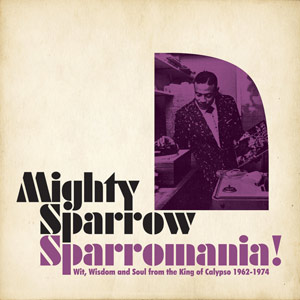
Sparrowmania! Wit, Wisdom and Soul from the King of Calypso 1962–1974
Strut
While his name might never be quite as well known to a mass audience and he never achieved the same amount of crossover success, Mighty Sparrow is arguably as towering and influential a figure in Caribbean music history as the mighty Bob Marley himself. While Marley helped bring reggae to its largest audience ever in the 1970s, and in the process helped fashion the concept of a “world music” movement as a force for liberation, the Trinidadian Sparrow (born Slinger Franciso in 1935 in Grenada) was helping to spread the calypso gospel internationally as early as the 1950s. Likewise, he could be as outspoken, political (in fact, he recorded a pro-Obama song, “Barrack the Magnificent,” during the 2008 campaign), and individualistic as Marley. Strut’s two-disc Sparrowmania! Wit, Wisdom and Soul from the King of Calypso 1962–1974 collects 28 tracks culled from one of the artist’s most fertile periods.
Though popular across the Caribbean, calypso is native to the island of Trinidad; the bright, buoyant, highly rhythmic Afro-Caribbean style has its musical origins in the slave culture of the island and has been performed since the early 20th century. Mighty Sparrow, influenced by American jazz of the 1930s and ’40s and calypso stars such as Lord Kitchener and Lord Invader (who wrote the international hit “Rum & Coca-Cola”), emerged as a force in the scene in the mid-50s with his 1956 mega-hit, “Jean and Dinah,” a song celebrating the departure of American GI’s from his homeland. This success prompted Sparrow to try his luck in the United States, where Calypso had been popular since at least World War II, with everyone from the Andrew Sisters and Robert Mitchum to Harry Belafonte (who’s 1956 Calypso! was a million seller) giving it a go. Sparrow didn’t hit pay dirt in America exactly, but his journey there marked a grand first step in spreading his own irreverent take on the sound around the world.
By the 1960s, however, Sparrow had, like Lord Kitchener before him, found some success in England and continued to churn out hits hugely popular there and at home. It was in the ensuing years—those covered by this set—that the Mighty Sparrow would solidify his name as the “Calypso King of the World.” A distinctive singer, Sparrow possesses a voice that can swoop around a fluttering melodic line one minute and descend to a dirty yet inviting growl the next. He is perhaps best known for using that voice to display a remarkable lyrical dexterity. It can be easy to miss, at first, with Sparrow’s big band wailing away behind their fearless leader, creating some of the most infectious, eminently danceable, and indelibly hummable music ever created.
A fun-loving, hyperactive, at times provocative storyteller with a penchant for wordplay, Sparrow shares a similar sense of humor with the most ribald bump-and-grind R&B singers of the 1950s and early ’60s. “Congo Man,” for example, is one of the singer’s most controversial songs, but not for the best of reasons. An over-the-top tale of two white women lost in the dark depths of the jungle, the song is so un-PC in its hyperbolic racial and sexual stereotyping, it’s hard to tell who exactly should be offended. That said, it is indeed one of a kind. While not all of the songs here push the boundaries of taste in quite the same way, they all represent Sparrow’s singularity as a songwriter. “The Slave,” to offer a contrast to “Congo Man,” presents a scathing, plainspoken story of a slave brought to the West Indies and offers just a taste of the singer’s willingness to get political. While the genre hybrid “Calypso Boogaloo” presents a droll tale of cross-cultural pollination in which Sparrow travels to New York City and learns of the then burgeoning Nuyorican sound from, ironically, “a big fat mamma from Mississippi.”
Sparrowmania, though a bit unwieldy at times, offers a very nice starting point for newcomers to the Mighty One’s exceptionally deep catalog. Experts will no doubt quibble with the song selection, and the sound quality might leave audiophiles wanting, but if the goal of the set is to offer a broad overview of an iconoclastic artist reaching the height of his powers, then Sparrowmania succeeds. It should also be mentioned that David Katz’s exhaustive liner notes are an indispensable resource for newcomers, augmenting Sparrow’s story with insight and giving it its proper historical, cultural and musical context.
Nate Knaebel
PAST PERFECTS
Alex Chilton, Free Again: The "1970" Sessions
The Lucy Show, Remembrances
Boddie Recording Company: Cleveland, Ohio
Smashing Pumpkins, Gish and Siamese Dream
U2, Achtung Baby
Can, Tago Mago
Leonard Cohen, The Complete Albums Collection
The Smiths, Complete
Void, Sessions 1981-83
Fac. Dance: Factory Records 12" Mixes & Rarities 1980-1987
Gregory Isaacs, The Ruler: 1972-1990
The Jimi Hendrix Experience, Winterland
Social Climbers
This May Be My Last Time Singing
